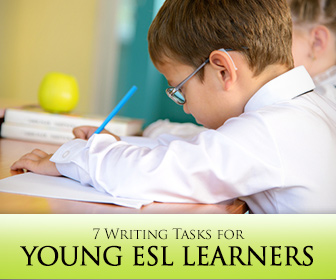Picture the perfect ESL classroom with young learners, if you will.
You are probably imagining a happy, smiling group of children who are dancing and singing. Or probably playing with flashcards or toys. They could also be drawing, painting or creating marvelous crafts. But you are probably not picturing them writing.
It makes sense, right? Maybe you teach preeschoolers – they can barely write their own names! At best, they can copy a few isolated words from the board. Children who are a little older are struggling to write well in their own language; how can they write in a second one? But young ESL learners can do a lot more writing than you give them credit for. It’s true they can’t do what most people consider “writing”, i.e., letters, stories or reports. Yet, it’s a good idea to get them started on writing as early as you can. They’ll be better equipped to tackle those lengthy writing tasks later. So, here are 7 writing tasks you can use in your ESL class. Some are perfect for introducing writing to your youngest learners. Others are useful for young learners who can write, but still need extra prompting or encouragement.

Try These 7 Writing Tasks for Young ESL Learners
-
1
Word Jumble
This activity is useful for those who have just started writing in English. Since writing whole sentences on their own can be rather challenging, this activity can help students understand word order, and yet, it gives them the support they need.
Divide students into small groups of three or four, or into pairs. Give each group a set of cards containing words that can be used to form a sentence. These words are clearly jumbled, in other words, in the wrong order. Students have to put them in order to make the sentence, and then copy the sentence onto their notebook or separate worksheet.
You may be tempted to give them a worksheet with a list of sentences where the words are in the wrong order, but with very young learners, it is essential for them to have cards they can manipulate and move around.
-
2
What Happens Next?
Give students the first sentence or beginning of a story, and ask them to complete the story. To make it fun, they can be given funny or even ridiculous sentences/situations (It was a clear, starry night when the cow jumped over the moon or Michael opened his sock drawer, and all his socks had disappeared.)
This helps students use their creativity and understand how sentences relate to one another to make a cohesive text.
-
3
What is Happening in This Picture?
This is a simple writing activity where you show students an illustration and ask them to write about what they see. illustrations that show a lot of things happening at the same time are great for this activity; students can choose or even create a small story that revolves around the whole scene.
Most often, if we ask students to “write” they have no idea where to begin. You can give them a visual prompt to get them started and to guide them in terms of content so that they won’t stray too far from the topic.
-
4
Story with a Twist
This is a great post-reading writing activity. After the reading, ask your students to change the ending. You can read a well-known classic or a story that is completely new to them. They can change a few details or change the outcome altogether. They will need to get creative here but they will be using a story they are familiar with and have that extra, needed support.
-
5
Let’s Write Together
This is a classic writing activity when you have a large group of young ESL students who don’t feel confident enough to write an entire story on their own. One student writes a sentence (or you can get the ball rolling yourself), and the next has to write the sentence that follows and so on till the story is complete. And it doesn’t have to be a “story”; they can write a news article or a journal entry.
This is a great task to promote cooperation and collaboration among students. Also, since each one will be completing a part of the text, they will have to make choices regarding text structure, i.e, decide if they need to start a new paragraph.
-
6
Yummy Writing
Give or show students a series of pictures that illustrate how a dish is prepared. The pictures should show the series of steps involved in a recipe but students have to write the instructions that go with each picture.
This is a great activity to practice imperatives and also how to give instructions.
-
7
What’s Missing?
Give students a text; it can be an e-mail, a report, a newspaper article or even a story. A part is taken out and students have to complete it with the missing information. Of course, they will completely make up what is missing. The important thing is not for the information to be accurate (for example, the time or day something happened) but coherent with the rest of the text.
Writing can be hard for young ESL learners – it’s hard enough in their native language.
But don’t make the mistake of discounting it as “too hard”. Instead, give them a nudge, a prompt and a little support, whether it is through the first words or images that go with the text. You will boost their confidence and make them happy little writers!
P.S. If you enjoyed this article, please help spread it by clicking one of those sharing buttons below. And if you are interested in more, you should follow our Facebook page where we share more about creative, non-boring ways to teach English.







